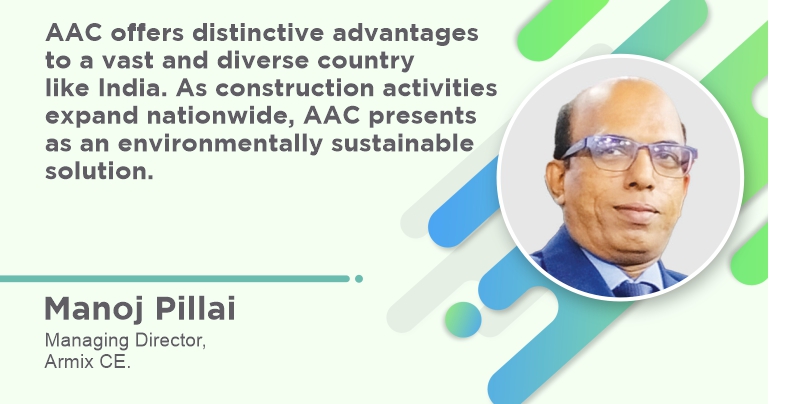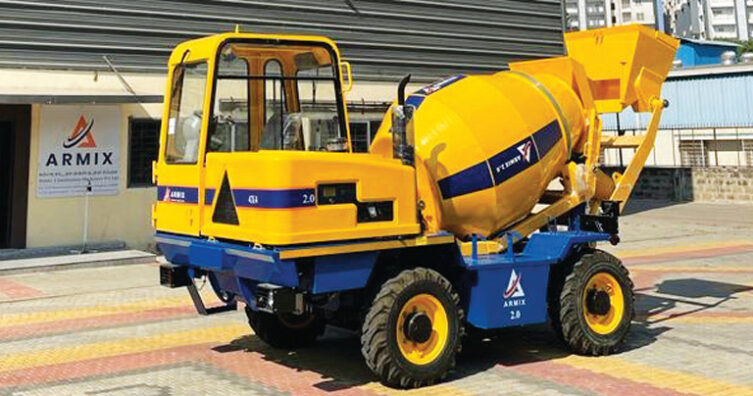Govt-Industry partnership essential for global growth of Indian CE Industry
By Edit Team | October 12, 2023 2:57 pm SHARE

AAC offers distinctive advantages to a vast and diverse country like India. As construction activities expand nationwide, AAC presents as an environmentally sustainable solution.
In this exclusive interview, we engage with Manoj Pillai, Managing Director of Armix CE, as he sheds light on the rising significance of AAC blocks, the intriguing enigma of the Indian construction equipment industry’s limited global outreach, the ripple effects of geopolitics on the sector, and much more.
Can you share specific challenges and milestones that have been instrumental in your journey?
Armix, with over two decades of experience and a deep-rooted presence in the transition industry, has witnessed and actively facilitated the growth of this sector. This journey began with a team of just five or six individuals, who have since amassed more than 23 years of expertise. Today, we proudly stand as a company with the capacity to cater to India’s dynamic needs and extend our footprint beyond the country’s borders.
Our machinery ranges from smaller plants valued at around one crore to massive projects reaching 30-40 crores. This wide spectrum covers various stages of construction projects, emphasising our ability to cater to diverse procurement needs in India and abroad.
As a technology provider, we take pride in our position, which allows us to meet the varied procurement needs of the industry. This extends not only to the Indian market but also to the international arena. Our active involvement in exporting infrastructure development technologies underscores our commitment to advancing the global infrastructure landscape.
You recently attended the ICAAC 2023 International Conference. Could you share some insights from the conference that could impact the construction industry?
ICAAC is a notable global platform, but India’s AAC export presence could be more robust, with few key players like Armix. Countries like Germany, the Netherlands, and emerging competitor China dominate the AAC market. The AAC offers benefits like insulation, cost savings, and reduced labour, which are crucial for urban and infrastructure development. Our attendance at the Prague conference aligns with promoting AAC in India, offering insights and innovation opportunities. The event, attended by a handful from India but attracting global AAC figures, underscores its industry significance and the need for increased Indian participation.
What factors may have contributed to the low participation of Indian companies at international conferences such as ICAAC 2023?
The AAC seminar’s audience was mainly existing plant operators and customers, attributed to the industry’s niche nature. The high cost high cost for travel and
entry fee will not be helpful for any trade visitor.
of over ₹ 2,00,000 for attendance could deter potential participants. Indian government and organisations should recognise the AAC industry’s potential as India becomes an appealing manufacturing hub, highlighted by Tesla and Apple’s initiatives. However, official Indian representation is often missing at major global events like Big Five and Bauma, focusing more on developing nations’ events. This focus must shift towards top-tier international platforms for long-term benefits and growth.
The AAC block is steadily gaining prominence in the industry and is emerging as a key player. How do you view the evolving landscape in this regard?
AAC is a sustainable construction solution for India, with fly ash from thermal power plants as a primary raw material. Repurposing fly ash for AAC production enhances construction efficiency and sustainability, offering reduced carbon emissions and improved insulation. The collaboration between government, institutions, and major power producers is crucial to promote AAC, especially with the ban on clay brick production due to environmental concerns. Countries like the Czech Republic exemplify the successful utilisation of fly ash in AAC. Seminars and conferences facilitate knowledge exchange, advancing the adoption of sustainable construction materials like AAC.
How is the construction industry in India affected by global geopolitical conflicts?
The Palestine-Israel conflict highlights geopolitics’ impact on construction. Being an Indian company, we have limited export activities and understand the widespread effects of such conflicts. India’s significant diaspora in the Middle East and involvement in major projects make the nation vulnerable to geopolitical disputes, affecting project timelines and cash flows. Our engagement in the Middle East exacerbates this vulnerability. Conflicts between Russia and Ukraine can also influence investments, with nations like Uzbekistan emerging as safe investment destinations due to neutrality and resources. Dubai’s role as a haven during unrest underscores the construction industry’s susceptibility to geopolitical shifts. Collaborative resolution efforts are crucial for industry stability.

Indian companies have limited exposure to foreign markets. Are there any avenues where the government or industry bodies can provide support to facilitate this expansion?
The Indian construction equipment industry lags behind a few global counterpart brands in penetrating international markets. A multifaceted approach involving both government and industry could reverse this trend. The government could promote export initiatives, provide financial incentives, and organise trade missions to encourage global expansion. Participation in international exhibitions allows networking and global showcasing of Indian products. Investing in R&D and skill enhancement ensures competitiveness and adherence to international standards. Collaborations with esteemed institutions like IITs can spur innovation, elevating the industry’s global stance.
With the smart city movement gaining momentum, what role does Armix Construction Machinery play in providing solutions for infrastructure development and technological integration in these cities?
Smart City development integrates technology, training, and infrastructure, aiming for inclusive and connected environments. Our company offers comprehensive construction solutions, uniting batching, mixing, transportation, and machinery for efficient infrastructure development. Maximising production plants around the clock can expedite city development and improve ROI. A holistic construction approach, minimising external supplier reliance, is key to building smarter, connected, inclusive cities.
What is the potential of conference and convention tourism in India, and how can it benefit the construction industry?
Prominent international events like Switzerland’s Lab Bauen and Germany’s Munich Trade Fair attract global participants from various sectors. These events impact local economies, boosting hospitality, travel, and related industries. For example, a Dubai construction exhibition annually attracts thousands, fostering a vibrant business ecosystem. Munich’s week-long event draws up to 700,000 visitors, sparking extended economic activity.
India, however, hosts fewer globally significant events. Bauma India in Delhi sees under 50,000 visitors, hampered by infrastructure and accessibility issues. Noida and Bangalore’s exhibition centres face similar challenges. To tap into the economic potential of international events, India must develop modern centres and improve infrastructure. The New Delhi Exhibition Centre represents a positive step. Enhancing conference and convention tourism infrastructure could significantly boost various sectors, driving economic growth.
Spokesperson – Manoj Pillai, Managing Director of Armix CE
Cookie Consent
We use cookies to personalize your experience. By continuing to visit this website you agree to our Terms & Conditions, Privacy Policy and Cookie Policy.




































-20240213125207.png)

























